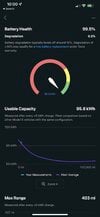For Rear-Wheel Drive vehicles,
If the image of the battery displays ‘50%’ and ‘100%’: Tesla recommends that you keep your charge limit to 100%, even for daily use, and that you also regularly charge your vehicle to 100% . If your vehicle has been parked for longer than a week, Tesla recommends driving your vehicle as you normally would and charge to 100% at your earliest convenience.

 www.tesla.com
www.tesla.com
If the image of the battery displays ‘50%’ and ‘100%’: Tesla recommends that you keep your charge limit to 100%, even for daily use, and that you also regularly charge your vehicle to 100% . If your vehicle has been parked for longer than a week, Tesla recommends driving your vehicle as you normally would and charge to 100% at your earliest convenience.

Range Tips | Tesla Support
Your Tesla vehicle continuously monitors its energy level and proximity to known charging locations to provide range assurance. To maximize efficiency, it is important to know the factors that impact range and the recommended ways to reduce energy consumption.




